Welcome to the July update for the project of building our jet hydroplane Longbow as we work towards making a credible British attempt upon the Outright World Water Speed Record (WWSR) of 317.58mph set in 1978 by Australian Ken Warby MBE with his iconic fastest boat in the world, Spirit of Australia.
Firstly this month we are so very proud and honoured to announce not one but two new sponsors and partners of the Longbow venture as follows:
It is with many thanks to David Baines, Production Director of Stockport based Nelson Tool and Manufax Engineering Ltd that along with Leading Edge and Metrology this international group of companies have come on board with Longbow to provide engineering support:
Amongst their vast range of design and precision engineering capabilities, I have no doubt a project many of our followers will know well is the Bloodhound land speed record car and Manufax were previously an engineering partner with that project. In that instance they were able to assist with the manufacture of components for the tailfin assembly, upper chassis and lower chassis, as well as providing the assembly tooling. The upper chassis of the car was manufactured using aluminium ribs with titanium stringers running along the length of the chassis. A rolled titanium skin was then riveted over the top as shown in the following photo courtesy of the company:
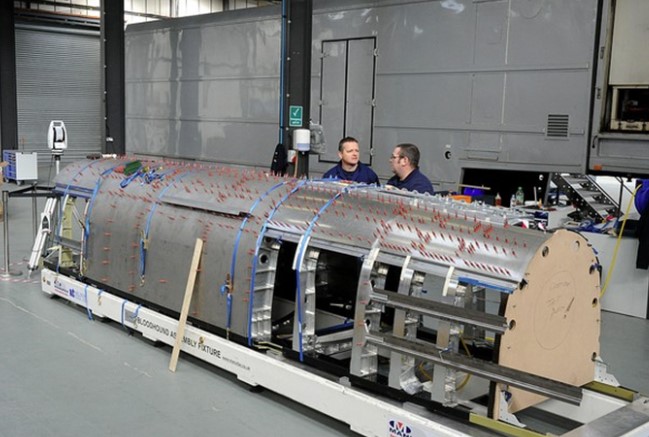
Our second new sponsor for the Longbow jet hydroplane project is Sigmatex who have manufacturing bases in the Americas, Asia and Europe. For well over 30 years this group of companies have been a pioneer in the design, development and manufacture of carbon fibre textiles to support industries as diverse as automotive, aerospace and renewable energy initiatives:
The U.K. sector of Sigmatex is based at Runcorn and it is with many thanks to their Business Development Manager, Umar Ahmed who upon hearing of our venture has been so helpful and enthusiastic for his company to offer support by way of supplying us with certain specific grades of carbon fibre fabric. When informing our design engineer Paul Martin of this news I was surprised what a small world composite fabric manufacturing is, with Paul then recalling how Sigmatex produced carbon fibre fabric to his specification during the period he was with Formula 1 car constructor at the time Leyton House Racing. A little fun fact is a certain engineer and aerodynamicist who is prominent in F1 at the moment, Adrian Newey also spent some time there.
Since our last update we were delighted to be interviewed by the very well known Maritime Consultant and Editor of Powerboat & Rib Magazine, Hugo Montgomery-Swan who is not only a thoroughly nice chap, he has also reviewed hundreds of boats and products, written a book titled ‘Heavy Weather Powerboating’ and undertaken record breaking offshore expeditions. Hugo stumbled across our project of building Longbow and was instantly hooked upon the venture to the extent that he then approached us to write an article upon the project for which it has now published in the latest edition of the highly popular Powerboat & Rib Magazine. This special feature by the magazine has been so kindly issued by them as a free online download from the following link for which we hope you enjoy:
As mentioned last month Chartered Marine Engineer and Chartered Mechanical Engineer Rob Irvine of the Osprey Powerboat Rescue Team has so very kindly come on board with Longbow to assist us in a number of ways. Unfortunately whilst on a Rescue at Windermere in the Lake District Rob suffered a nasty hand injury requiring emergency plastic surgery and we wish him all the very best for a speedy recovery.
Some of those following Longbow have asked us to comment upon windshields relating powerboating and in particular those used in jet hydroplanes for which I trust you find the following information of interest.
Windshields of boats to some extent mirror windshields in aircraft in that they are typically formed from certain types of glass or alternatively ‘clear plastic’ materials. In relation to the plastic materials these in the main can sub divided into two groups:
1. Poly (methyl methacrylate) (PPMA), a thermoplastic commonly referred to as acrylic and manufactured under several different trade names for example Perspex.
2. Polycarbonate a group of thermoplastic polymers containing carbonates and an example of a trade name for this materials is Lexan.
Whilst both acrylic and polycarbonate are available as clear plastic material, their ability to withstand sudden impact could not be more different from one another. As a mischievous child I can remember finding out just how easily a standard pane of glass to our neighbour’s greenhouse would shatter with my catapult much to our neighbour’s annoyance, for which I also recall my father’s punishment was both physically and financially painful!
An improvement to repelling pesky kids with catapults is acrylic glazing which is relatively cheap to buy and comparatively easy to shape, whilst offering around seventeen times more sudden impact resistance than standard glass of the same thickness. However when failure through sudden impact does occur to acrylic it shatters into fairly large, sharp and consequentially dangerous lumps of plastic that nobody wants a face full of, be that in a greenhouse or in our case whilst driving a boat at speed.
Polycarbonate is around two hundred and fifty times more resistant to sudden impact than standard glass such that in no way can acrylic possibly hope to compete with polycarbonate over the requirement to resist sudden impact. Hence why polycarbonate is used not only for windshields but also for protection from sudden high impact in security situations for example police crowd control shields and shop security barriers.
The jet hydroplane Bluebird from 1956 to when the boat crashed on 4th January 1967 killing Donald Campbell had an acrylic rounded windshield canopy of only around 6mm thickness which is around quarter of an inch.
They say a picture speaks a thousand words and the following video comparing sudden impact tests to glass, acrylic and polycarbonate sheets of the same size and thickness (in this case 5mm) really does speak for itself:
Robinson helicopters have produced a lovely video clip of their polycarbonate windshields as an advertisement for them being able to resist sudden impact strike:
Given the above it is therefore of no surprise that the international governing body for powerboating, the Union Internationale Motonautique (UIM) stipulate that windshields for enclosed cockpits have to be made from polycarbonate shatterproof material. This stipulation for polycarbonate for racing boat windshields to enclosed cockpits is mirrored across other types of boat racing organisations such as the American drag boats that run under their own rules.
This mandatory requirement by the governing bodies of powerboating across the world to use polycarbonate for windshields is on the grounds of providing by far the best windshield safety to protect the driver of the craft from serious injury or worse from a windshield failing as a result of sudden impact with water and other objects. Examples of that sudden impact situation being the craft crashing into the water surface, collision with other boats on the water, or striking a bird.
In addition to safety of the driver it should also be appreciated that an injured or worse driver especially if unconscious may result in an out of control craft of considerable mass still travelling at high speed. The consequences of that are a hazard of injury or worse to other persons into which that out of control craft might then travel, be that either on the lake or shoreline, particularly where that shoreline is of considerable length and the number of persons on that unprotected shoreline is expected to be crowded. The Lake District for instance being a highly popular tourist attraction has around 18 million visitors a year.
Bird strikes for aircraft primarily occur during take off and landing at airports that are land based, in constant use by aircraft and permanently dedicated to this means of transport. Consequentially all year round airports take a number of measures to discourage birds from flying, gathering and nesting at such locations in order to minimise bird strikes with aircraft. Nevertheless despite these measures 13,000 bird strikes during a year occurred in the USA and around 1,500 annually in the UK, along with many which go unreported.
Moving away from airports to Coniston Water in the Lake District, this is a relatively long stretch of water at just over five miles but only averages around 500 metres wide, set in a countryside park full of wildlife and with that a high population of birds nesting, waterfowl paddling along having a great day being constantly fed by the public. Activity of people on the lake is normally limited to under 10mph.
Ken Warby had bird strikes with his jet hydroplane, Spirit of Australia, Dave Warby has had bird strikes with his jet hydroplane Spirit of Australia 2 and Donald Campbell had bird strikes with his jet hydroplane Bluebird. In 1966 Donald had two bird strikes with Bluebird on Coniston, hitting a seagull on the 13th December, then ran the boat again on the 14th and 25th but hit another bird with Bluebird in that instance a duck on the 27th of December so it is something we definitely need to consider with Longbow.
As stated there all manner of birds in the Lake District but a quick online search reveals flocks of birds that gather there include:
Mallard Ducks – weight range 1.5 – 3.5 lbs (0.7 – 1.6 kg)
Canada Geese – weight range 6 – 24 lbs (2.7 – 10.9 kg)
Mute Swans – weight range 20 – 25 lbs (9 – 11.5 kg)
There are many factors that affect the impact of bird strikes to windshields for instance the speed of the event, bird weight, bird density and its rigidity, angle of impact, shape and rigidity of windshield surface and windshield material type. Even with certain assumptions you quickly get into complex equations when for the purposes of this discussion we just wish to provide a visualisation of such an event for folk who are laypersons in such matters to get their head around.
When people speak about how hard something suddenly hits you in an accident it is often difficult to visualise what that value is in day to day terms so just for fun let’s see if we can assist with that.
Kinetic energy is the energy something has due to its motion and the standard unit for measuring energy is joules, so kinetic energy is likewise measured in joules. Referring back in this discussion to the guy in one of the previous video links swinging an average sized sledge hammer, then as a starting point it may be interesting to determine just how much kinetic energy there likely was in that swing of the sledge hammer.
A medium sized sledge hammer weighs around 10 lbs or 4.5kg and when trying to aim it at something by swinging it sideways a speed of around 10 metres per second is not an unreasonable value to use.
The kinetic energy will be half times the mass of the hammer times the velocity of the hammer squared but to save you doing the maths, there is a handy online calculator for this equation as follows:
https://www.omnicalculator.com/physics/kinetic-energy
So using the above we get the kinetic energy of the sledgehammer swing at around 230 joules.
Now let’s put in figures to that online kinetic energy calculator for say a duck weighing 3 lbs with a sudden impact event of 150mph and you get a kinetic energy value for that episode of 3,059 joules which is 13 times more energy in that event than your sledge hammer hit.
Putting in values to the above online calculator for a goose or swan of say 20 lbs weight and a sudden impact event at 150mph gives you a kinetic energy of 20,395 joules.
Now let’s swap over to this other handy little online calculator for the force of a falling object where it allows us to set different values for weight and height of fall in relation to the kinetic energy value when it hits the ground:
http://hyperphysics.phy-astr.gsu.edu/hbase/flobi.html
So if we want to get to a kinetic energy (KE) value of around 3,059 joules for a duck 150mph impact as referred to above then our falling object calculator equates that to being like hit on the head by a weight of around 8kg / 17 lbs (say a small microwave) dropped from a height of approximately 39 metres / 127 feet which is roughly like dropping it from the balcony of 13th floor level high rise building.
For a goose or swan impact at 150mph to get to around the 20,395 joules of kinetic energy previously calculated and using the above online formula would be like getting hit on the head by somebody dropping a 50kg / 110 lb weight (which is around two cement bags wrapped together) from again a height of around 39 metres / 127 feet, the 13th floor of a high rise building.
In either case if you were stood underneath you would be dead from the force of the impact.
What plays a massive part in the kinetic energy values is speed and by that I mean if we reduce the speed of the impact down to say 70mph which is still motorway car speeds so not slow by any stretch of the imagination; then our 3 lb weight duck impact reduces to only 666 joules which is a massive reduction from the 3,059 joules of energy impact at 150mph.
Perhaps people will also begin to appreciate what a challenge Longbow is given that 3 lb duck strike at 400mph becomes 20,755 joules and our 20 lb swan becomes 217,555 joules which is like dropping a baby elephant off our 13 floor balcony and it landing on top of you.
For modern enclosed cockpit powerboats the windshield is at eye level only and the position of that clear windshield is at a distance that is well away from the driver’s head. In the example shown below you can see a horizontal band of polycarbonate windshield at eye level that the driver looks out through the cockpit rather like peering through a letterbox.
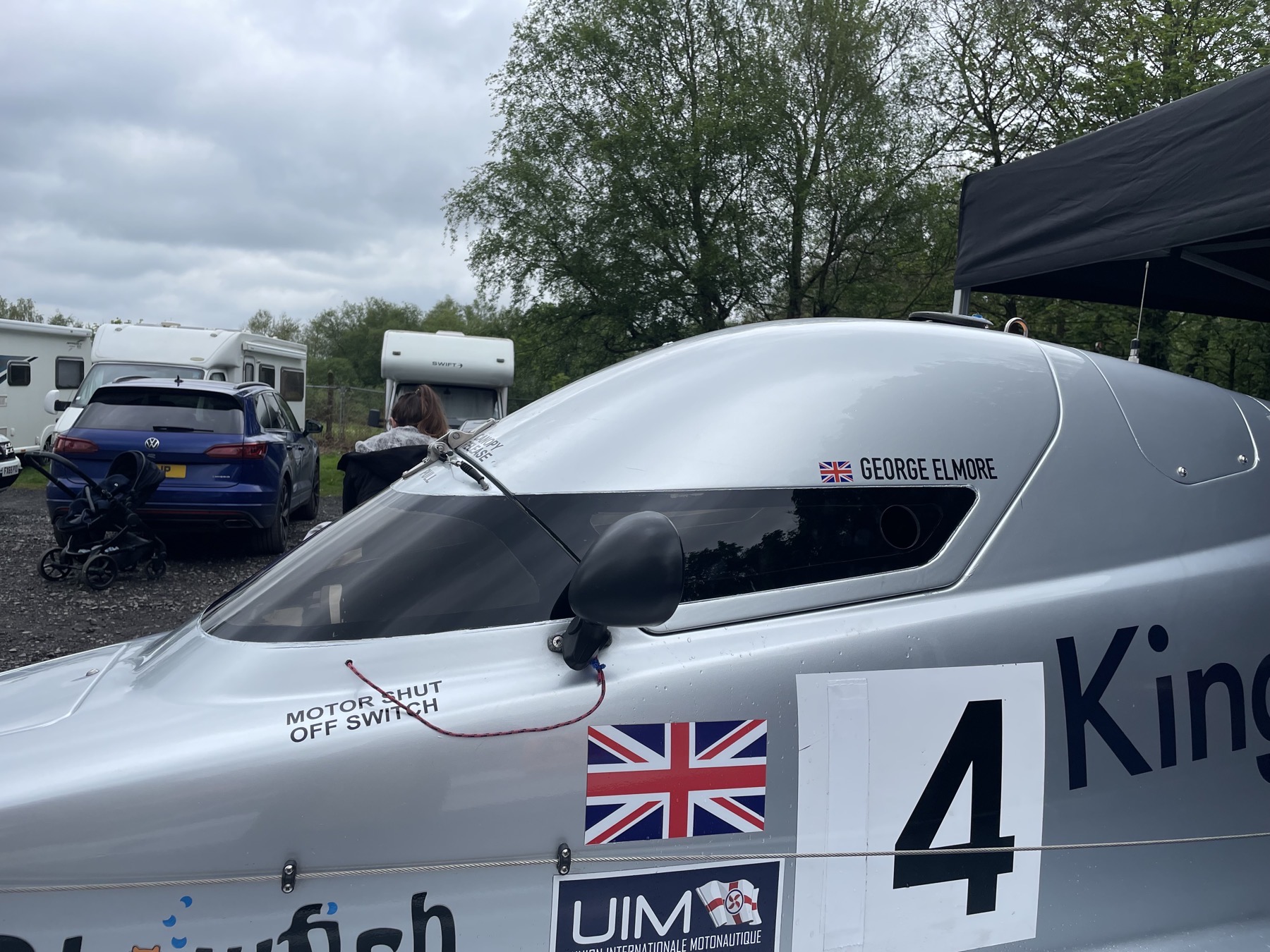
Over the driver’s head for an enclosed modern powerboat cockpit is normally a composite upper cockpit structure including lid through which the driver enters and exits.
With this type of set up the polycarbonate windshield is designed in the event of sudden impact from say bird strike to deform and absorb that energy in a similar manner to that of the helicopter polycarbonate windshield as shown in the previous video. That is to say it causes a ripple effect as a dissipating wave of energy that travels from point of impact in all directions over the windshield until it reaches the surrounding cockpit structure that then also in part absorbs and dissipates the energy from that sudden impact event.
As mentioned previously with a letterbox shaped windshield in a modern enclosed cockpit powerboat this ripple effect as the polycarbonate canopy deforms under sudden impact is of no consequence to the driver as they are sat well away from it.
The UIM powerboat rules for enclosed cockpits state there must be a minimum of 100mm / 4″ clear distance between top and sides of driver’s helmet and the surrounding cockpit structure as shown below:
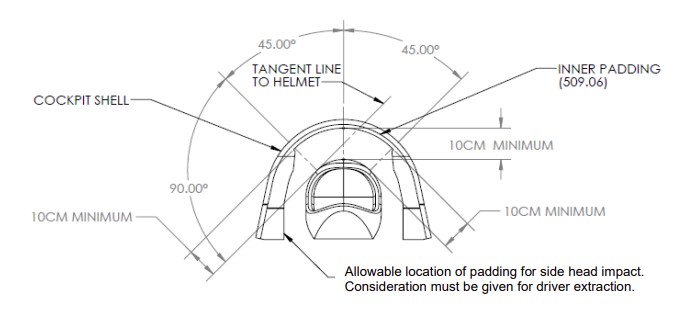
Chairman of the UIM Cockpit Safety Committee Sergio recalled to me only a few days ago that this minimum clearance distance was not just some arbitrary stroke of the pen in the UIM rule book, it was as a result of considerable consultation with research centres and universities looking at post accident analysis with boats and other areas of motorsport including many of those that sadly resulted in fatalities.
Seat belt harnesses for boat cockpits can be selected to allow varying degrees of stretch to them under sudden impact situations. One might think the best driver harness for a racing powerboat would be one with very little stretch to the material at all but the downside to this is the less the harness stretches the greater the G loads of the sudden impact event are transferred to the driver themselves and with greater G loads comes greater injuries and fatalities. In effect the driver seat harness might be likened to a shock absorber on a car, where with no stretch of the belt being like driving with very stiff suspension on a bumpy road with all of that jarring transferred very harshly to the driver.
A little fun fact whilst discussing seat belts is the designers of Bluebird, Ken and Lew Norris also went on to originally design the inertia reel seatbelt we all now use for cars.
Even when using driver seat harnesses with very little stretch what one finds in sudden impact situations is the body itself stretches and deforms under the G loads it endures as a result of the event.

Accordingly it is primarily for this issue that the 100mm clearance between driver helmet and cockpit structure is a mandatory requirement by the UIM in addition to the maximum lay back angle of 45 degrees that the UIM allow.
Aerodynamically we would like to have Longbow’s cockpit as low in the hull as we can in order to minimise the aero drag of the boat but the days of where Lee Taylor laid on his back in the hull of the jet hydroplane Hustler to go quicker than Bluebird and break the water speed record for the USA at 285.22mph in 1967 are long gone. Safety for the driver, the public and everyone else involved has to be the number one priority these days.
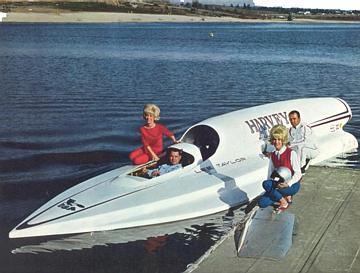
Within the last few weeks we were deeply shocked by the very sad news indeed of four unrelated fatal accidents at club level power-boating, for which all involved with Longbow pass on our sincere condolences to the family and friends of Brett Duncan (GB), Tomi Huuka ((FIN), Treiden Schliecher(USA) and Dustin Pearson (USA).
Whilst there has and continues to be so much done by the governing bodies of powerboating with their regulations and guidance to keep people as safe they can, these tragic events are a stark reminder that travelling at speed upon the water is not without risk.
For ourselves with Longbow we have chosen the F16 military fighter windshield canopy as used by drag boats in the USA and other high speed powerboats because of its existing bird strike rating well beyond the Outright World Water Speed Record of 317mph but that choice was just the starting point. If we do use that canopy it will be further chopped down to a letterbox narrow profile for the driver to look through and in addition to that the canopy for Longbow’s cockpit will require further support by way of both the carbon / Kevlar composite sandwich into which that frame is attached to and also by way of the high tensile T45 tubular steel cage supporting that canopy.
This being due to the fact that we have not only had to consider bird strikes but also the ability of the windshield to withstand impact with the lake surface as a worst case scenario of catastrophic crash of the craft at record speeds and beyond.
In this regard our design engineer Paul Martin has had to produce a mountain of analysis not just in relation to how the canopy might deform and transfer those loads to the surrounding cockpit structure but also in relation to the additional structure required to support that canopy at various points. Even though in our case there are competing teams for the record we intend to attempt we will be submitting that analysis for pier review by the powerboating governing bodies. This also includes but is not limited to compliance with the minimum 100mm clearance values required between top of driver helmet and enclosed cockpit structure.
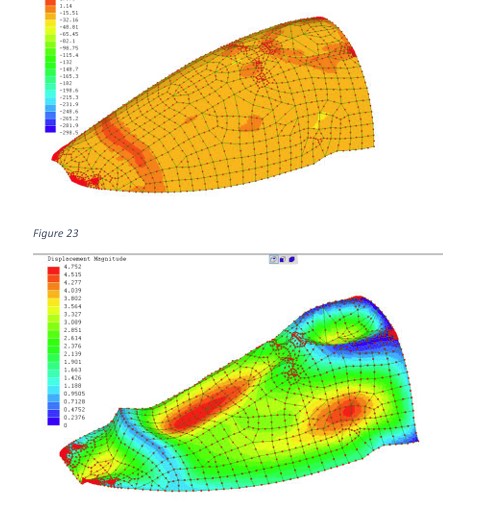
We make no apology for the time this driver cockpit capsule is taking to design because we ourselves have to be satisfied as well as those we submit that design for peer review to being equally satisfied that it will meet its design criteria.
So that is all for now folks and if you have not already done so please follow our page on Facebook for updates as the project develops.
